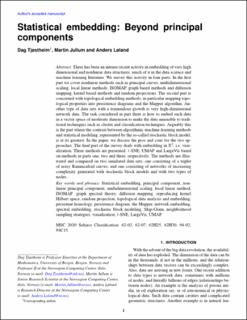| dc.contributor.author | Tjøstheim, Dag Bjarne | |
| dc.contributor.author | Jullum, Martin | |
| dc.contributor.author | Løland, Anders | |
| dc.date.accessioned | 2023-12-04T10:26:31Z | |
| dc.date.available | 2023-12-04T10:26:31Z | |
| dc.date.created | 2023-09-27T14:30:33Z | |
| dc.date.issued | 2023 | |
| dc.identifier.citation | Statistical Science. 2023, 38 (3), 411-439. | en_US |
| dc.identifier.issn | 0883-4237 | |
| dc.identifier.uri | https://hdl.handle.net/11250/3105785 | |
| dc.description.abstract | There has been an intense recent activity in embedding of very high-dimensional and nonlinear data structures, much of it in the data science and machine learning literature. We survey this activity in four parts. In the first part, we cover nonlinear methods such as principal curves, multidimensional scaling, local linear methods, ISOMAP, graph-based methods and diffusion mapping, kernel based methods and random projections. The second part is concerned with topological embedding methods, in particular mapping topological properties into persistence diagrams and the Mapper algorithm. Another type of data sets with a tremendous growth is very high-dimensional network data. The task considered in part three is how to embed such data in a vector space of moderate dimension to make the data amenable to traditional techniques such as cluster and classification techniques. Arguably, this is the part where the contrast between algorithmic machine learning methods and statistical modeling, represented by the so-called stochastic block model, is at its greatest. In the paper, we discuss the pros and cons for the two approaches. The final part of the survey deals with embedding in
R2, that is, visualization. Three methods are presented: t-SNE, UMAP and LargeVis based on methods in parts one, two and three, respectively. The methods are illustrated and compared on two simulated data sets; one consisting of a triplet of noisy Ranunculoid curves, and one consisting of networks of increasing complexity generated with stochastic block models and with two types of nodes. | en_US |
| dc.language.iso | eng | en_US |
| dc.rights | Navngivelse 4.0 Internasjonal | * |
| dc.rights.uri | http://creativecommons.org/licenses/by/4.0/deed.no | * |
| dc.subject | Statistical embedding | en_US |
| dc.title | Statistical Embedding: Beyond Principal Components | en_US |
| dc.title.alternative | Statistical Embedding: Beyond Principal Components | en_US |
| dc.type | Journal article | en_US |
| dc.type | Peer reviewed | en_US |
| dc.description.version | acceptedVersion | en_US |
| cristin.ispublished | true | |
| cristin.fulltext | postprint | |
| cristin.qualitycode | 2 | |
| dc.identifier.doi | 10.1214/22-STS881 | |
| dc.identifier.cristin | 2179499 | |
| dc.source.journal | Statistical Science | en_US |
| dc.source.volume | 38 | en_US |
| dc.source.issue | 3 | en_US |
| dc.source.pagenumber | 411-439 | en_US |
| dc.relation.project | Norges forskningsråd: 237718 | en_US |
| dc.subject.nsi | VDP::Mathematics and natural science: 400::Mathematics: 410 | en_US |
| dc.subject.nsi | VDP::Mathematics and natural science: 400::Mathematics: 410::Statistics: 412 | en_US |

